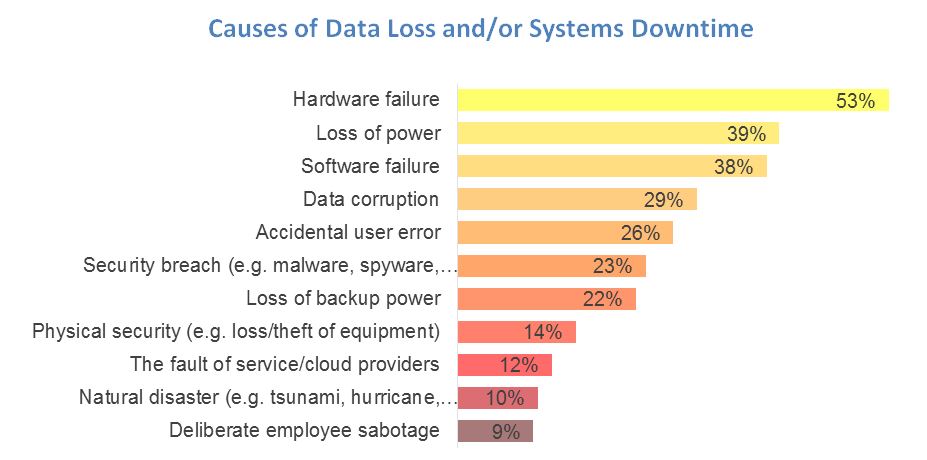 Outages and data loss are an all too familiar occurrence. In the recently announced EMC Global Data Protection Index, 64% of companies said they had experienced major disruptions in the past 12 months. The study revealed that while natural disasters and other major catastrophes make the headlines, it is common place incidents such as power loss and hardware failures that are most likely to take your systems out and corrupt your data. I have listed below the top causes of disruptions (in reverse order) as revealed in the study, and some tips on how to stop them spoiling your holiday plans.
Outages and data loss are an all too familiar occurrence. In the recently announced EMC Global Data Protection Index, 64% of companies said they had experienced major disruptions in the past 12 months. The study revealed that while natural disasters and other major catastrophes make the headlines, it is common place incidents such as power loss and hardware failures that are most likely to take your systems out and corrupt your data. I have listed below the top causes of disruptions (in reverse order) as revealed in the study, and some tips on how to stop them spoiling your holiday plans.
10. Deliberate Employee Sabotage
Coming in at number 10 is deliberate sabotage. Can you imagine the person who sits in the next cubicle one day taking out your systems or sabotaging your data? Well it happens, and certainly highlights the need for role based security (and also not forgetting to give everyone a secret Santa present!). On top of that, it points to the need for a robust data protection strategy that ensures that multiple and physically separate copies of data exist for the purposes of recovery.
9. Natural Disaster (e.g. tsunami, hurricane, earthquake)
When you think of catastrophes (and I don’t mean over cooked turkeys), you generally think of major natural disasters, and there are plenty of recent examples. There is not much you can do to prevent them, however when they strike you need to ensure you have a replication solution that puts your data far away from the trouble, with a quick restart capability.
8. Service Provider/Cloud Provider Outage
With the rise of cloud, it is not surprising that cloud outages make the Top 10. It is more critical than ever that your organization has a protection strategy that is inclusive of off-premise workloads (vCloud Air, Amazon, Azure) and applications born in the cloud (e.g. SFDC, Google docs and Office 365).
7. Physical Security (e.g. loss/theft of equipment)
Hopefully no one has stolen a server from your data center recently. Most likely theft or loss has occurred with end point devices such as laptops and tablets. Ensure you have a mobile backup strategy and a File Sync ‘n Share solution. It also helps if you can remotely destroy your data on the lost device.
6. Security Breach (e.g. malware, spyware, viruses)
Unfortunately this is the new norm. Of course you want to keep the bad guys out, buts once they have penetrated your security defenses, you really need to have a gold copy of your data, independent and separate from your production data.
5. Accidental User Error
Whenever there are humans involved, there are always going to be accidents. The only way to minimize this is to automate and standardize all of your administration and data protection tasks. (And also make sure your employees don’t go back to work after the end of year party).
4. Data Corruption
Database corruption is common and highlights the need for Continuous Data Protection (CDP). CDP solutions provide a DVR like capability that allows you to ‘rewind’ copies of data to the point before corruption occurs.
3. Software Failure
Application failure happens all too often, and when it strikes you need a fast recovery. The ability to restart quickly is key, or even better, deploy an active-active architecture that keeps your application continuously available.
2. Loss of Power (including backup power)
It’s surprising how common this occurrence is, and can affect a single device, a data center, a building or an entire city. Remote site failover with a matched data mobility solution will get you out of trouble here.
1. Hardware Failure
And finally, the number one cause is hardware failure. Despite all of the advanced features built into modern data centers, hardware still fails. Like software failures, it is critical that you have a business continuity strategy that is aligned to your application and data service level agreements. You won’t even notice hardware failures with a well-run hybrid cloud – I would put this on top of my holiday present list.
If you want to have a stress free holiday, you need to employ a data protection strategy that supports the availability and protection requirements for all of your critical data, no matter where that data is or how it is generated. Think of data protection as a continuum, a multi-tiered solution that works together, aligned to the most stringent application requirements from zero downtime and no data loss, to various point-in-time recoveries.
The list of all causes with frequencies is detailed below, and the full report can be found on the EMC Global Data Protection Index site.
